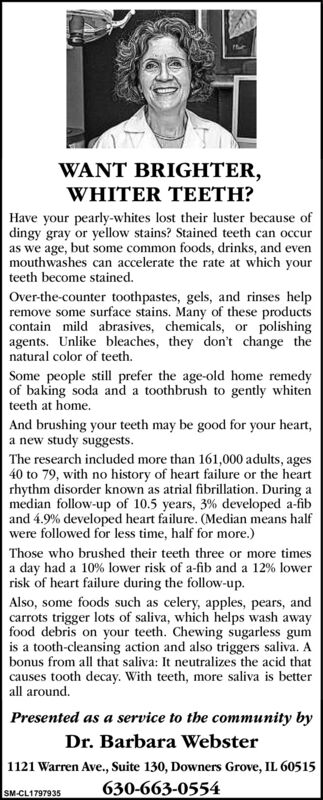Advertisement

-
Published Date
August 12, 2020This ad was originally published on this date and may contain an offer that is no longer valid. To learn more about this business and its most recent offers, click here.
Ad Text
WANT BRIGHTER, WHITER TEETH? Have your pearly-whites lost their luster because of dingy gray or yellow stains? Stained teeth can occur as we age, but some common foods, drinks, and even mouthwashes can accelerate the rate at which your teeth become stained. Over-the-counter toothpastes, gels, and rinses help remove some surface stains. Many of these products contain mild abrasives, chemicals, or polishing agents. Unlike bleaches, they don't change the natural color of teeth. Some people still prefer the age-old home remedy of baking soda and a toothbrush to gently whiten teeth at home. And brushing your teeth may be good for your heart, a new study suggests. The research included more than 161,000 adults, ages 40 to 79, with no history of heart failure or the heart rhythm disorder known as atrial fibrillation. During a median follow-up of 10.5 years, 3% developed a-fib and 4.9% developed heart failure. (Median means half were followed for less time, half for more.) Those who brushed their teeth three or more times a day had a 10% lower risk of a-fib and a 12% lower risk of heart failure during the follow-up. Also, some foods such as celery, apples, pears, and carrots trigger lots of saliva, which helps wash away food debris on your teeth. Chewing sugarless gum is a tooth-cleansing action and also triggers saliva. A bonus from all that saliva: It neutralizes the acid that causes tooth decay. With teeth, more saliva is better all around. Presented as a service to the community by Dr. Barbara Webster 1121 Warren Ave., Suite 130, Downers Grove, IL 60515 630-663-0554 SM-CL1797935 WANT BRIGHTER, WHITER TEETH? Have your pearly-whites lost their luster because of dingy gray or yellow stains? Stained teeth can occur as we age, but some common foods, drinks, and even mouthwashes can accelerate the rate at which your teeth become stained. Over-the-counter toothpastes, gels, and rinses help remove some surface stains. Many of these products contain mild abrasives, chemicals, or polishing agents. Unlike bleaches, they don't change the natural color of teeth. Some people still prefer the age-old home remedy of baking soda and a toothbrush to gently whiten teeth at home. And brushing your teeth may be good for your heart, a new study suggests. The research included more than 161,000 adults, ages 40 to 79, with no history of heart failure or the heart rhythm disorder known as atrial fibrillation. During a median follow-up of 10.5 years, 3% developed a-fib and 4.9% developed heart failure. (Median means half were followed for less time, half for more.) Those who brushed their teeth three or more times a day had a 10% lower risk of a-fib and a 12% lower risk of heart failure during the follow-up. Also, some foods such as celery, apples, pears, and carrots trigger lots of saliva, which helps wash away food debris on your teeth. Chewing sugarless gum is a tooth-cleansing action and also triggers saliva. A bonus from all that saliva: It neutralizes the acid that causes tooth decay. With teeth, more saliva is better all around. Presented as a service to the community by Dr. Barbara Webster 1121 Warren Ave., Suite 130, Downers Grove, IL 60515 630-663-0554 SM-CL1797935
